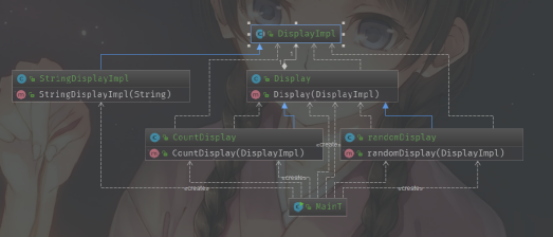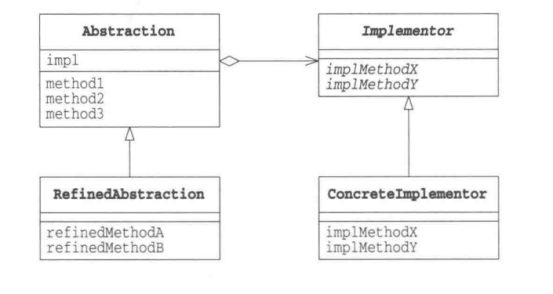Bridge???
Bridge的意思是“桥梁”。就像在现实世界中,桥梁的功能是将河流的两侧连接起来一样,Bridge模式的作用也是将两样东西连接起来,它们分别是类的功能层次结构和类的实现层次结构。
- 父类通过声明抽象方法来定义接口(APl):需要使用继承强关联方式,那么必须使用中间层抽象子类来实现方法的可变性。所以在聚合关系中考虑引入DisplayImpl 抽象层
- 子类通过实现具体方法来实现接口(APl):这种层次结构被称为“类的实现层次结构”。当我们以其他方式实现AbstractClass时,例如要实现一个AnotherConcreteClass时,类的层次结构会稍微发生一些变化。
理解职责
通俗理解办法:Bridge 是连通桥梁两端 是具体抽象层 与具体的实现类 建立关系的必然。
需要明确的:序中依赖于操作系统的部分划分为Windows版、Macintosh版、Unix版,那么我们就可以用Bridge模式中的“类的实现层次结构”来表现这些依赖于操作系统的部分。也就是说,我们需要编写一个定义这些操作系统的共同接口(API)的Implementor角色,然后编写Windows版、Macintosh版、Unix版的3个Concretelmplementor角色。这样一来,无论在“类的功能层次结构”中增加多少个功能,它们都可以工作于这3个操作系统上。
职责实现功能:完成不同功能的字符显示
在桥的哪一侧|名字|说明
|类的功能层次结构 ====>|Display|负责“显示”的类
类的功能层次结构 ====>|CountDisplay|增加了“只显示规定次数”这一功能的类
类的实现层次结构 ====>|DisplayImpl 负责“显示”的类
|类的实现层次结构 ====>|stringDisplayImp1“用字符串显示”的类
Main测试程序行为 ====>的类
UML


Code
Display:
public class Display {
/**
* 交给抽象子类去实现
*/
private DisplayImpl displayimpl;
public Display(DisplayImpl displayimpl) {
this.displayimpl = displayimpl;
}
protected void open(){
displayimpl.rawOpen();
}
protected void printr(){
displayimpl.rawPrint();
}
protected void close(){
displayimpl.rawClose();
}
public void display(){
open();
printr();
close();
}
}
假设需求改变 我们需要在Display基础上增加功能:
public class randomDisplay extends Display {
public randomDisplay(DisplayImpl displayimpl) {
super(displayimpl);
}
public void randomDisplay(int times) {
Random random = new Random();
int len=random.nextInt(times);
super.open();
for (int i = 0; i < len; i++) {
super.printr();
}
super.close();
}
}
public class CountDisplay extends Display {
public CountDisplay(DisplayImpl displayimpl) {
super(displayimpl);
}
public void multiDisplay(int times){
super.open();
for (int i = 0; i < times; i++) {
super.printr();
}
super.close();
}
}
书上没有明确这个 称之为 抽象实现者 :我暂且称之为 Bridge器 必须抽象
public abstract class DisplayImpl {
/**
* 作为bridge 强关联 解耦的关键性 地方 不可以为 class 必须为abstract class
*/
public abstract void rawOpen();
public abstract void rawPrint();
public abstract void rawClose();
}
测试:
**/
public class MainT {
public static void main(String[] args) {
Display display=new Display(new StringDisplayImpl("bridge design method"));
Display display1=new CountDisplay(new StringDisplayImpl("on first bridge"));
display.display();
display1.display();
((CountDisplay) display1).multiDisplay(3);
// 随机次数
Display display2=new randomDisplay(new StringDisplayImpl("two sencond bridge"));
((randomDisplay) display2).randomDisplay(5);
}
}